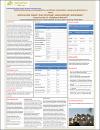| المؤلف | Elsayed, Fatma |
| المؤلف | Alhammadi, Aram |
| المؤلف | Alahmad, Alanood |
| المؤلف | Babiker, zahra |
| المؤلف | Kerkadi, Abdelhamid |
| تاريخ الإتاحة | 2020-10-26T09:32:40Z |
| تاريخ النشر | 2020 |
| اسم المنشور | Qatar University Annual Research an Exhibition 2020 (quarfe) |
| الاقتباس | elsayed f., alhammadi a., alahmad a., babiker z., kerkadi a., "Relationship between eating patterns and body composition among young females in Qatar.", Qatar University Annual Research Forum and Exhibition (QUARFE 2020), Doha, 2020, https://doi.org/10.29117/quarfe.2020.0219 |
| معرّف المصادر الموحد | https://doi.org/10.29117/quarfe.2020.0219 |
| معرّف المصادر الموحد | http://hdl.handle.net/10576/16802 |
| الملخص | The prevalence of obesity has been increased in Qatar, with the transition from healthy to unhealthy dietary habits. Behavioral factors that are associated with obesity are, long-term imbalanced energy intake, high screen time, skipping breakfast and physical inactivity. Changes in body composition and percent body fat (PBF) increase the risk of non-communicable disease. This study is the first study conducted in Qatar to investigate the relationship between dietary patterns and body composition among young females at Qatar University. This cross-sectional study consisted of 766 healthy female students Qatari and non-Qatari aged from 18-26 years randomly selected from different colleges at Qatar University. A validate questionnaire was used in order to collect data about healthy and unhealthy dietary patterns. Anthropometric measurements involved body weight, height,waist-to-height ratio (WHtR), waist circumference (WC), body mass index (BMI) and body composition using 'Seca285', 'Seca203' and 'InbodyBiospace720'. Dietary patterns were identified by using factor loading. Linear regression was used to estimate confidence intervals and regression coefficient. More than half of the participants had a normal weight (65.1%), whereas 22.8 % and 12.0% were overweight and obese, respectively. Fat mass, BMI and PBF were slightly increased with age, but there was no significant difference. Factor analysis identified two dietary patterns: unhealthy patterns and healthy patterns. The frequent intake of vegetables and fruits was significant among high PBF female students (p=0.045 and p=0.001, respectively). The frequent intake of fast food was higher for overweight female students but there was no significant difference (p=0.289), whereas, the frequent intake of sweetened beverages was associated with higher significant rate of normal weight among female students (p = 0.009). No significant relation was found between dietary patterns, BMI and PBF. In conclusion, body composition is not significantly associated with healthy and unhealthy eating patterns among young females |
| اللغة | en |
| الناشر | Qatar University Press |
| الموضوع | Eating Patterns, Body Composition, Obesity
|
| العنوان | Relationship between eating patterns and body composition among young females in Qatar |
| النوع | Poster |
|
dc.accessType
| Open Access |


